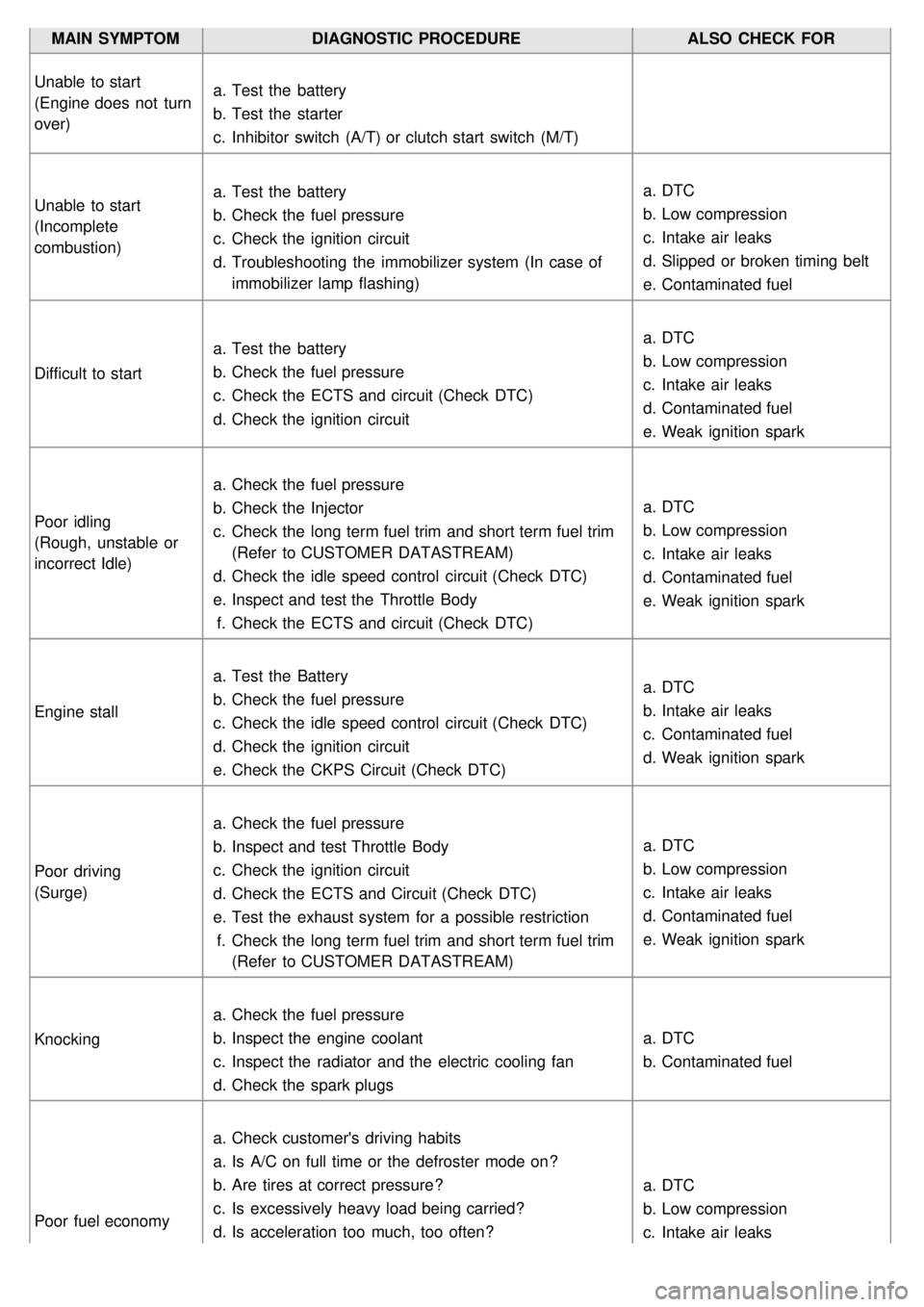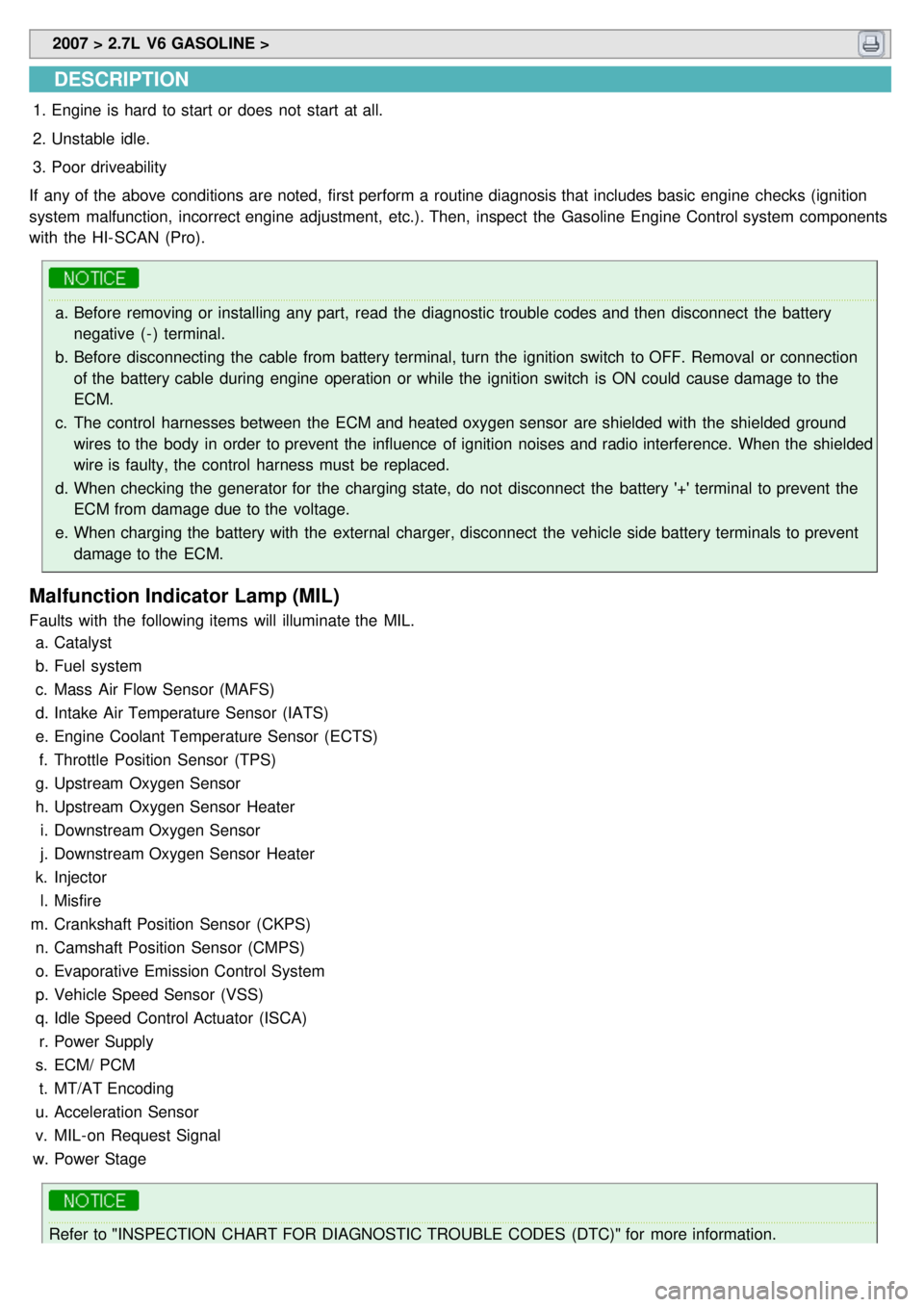Page 176 of 1575

2007 > 2.7L V6 GASOLINE >
STARTER CIRCUIT TROUBLESHOOTING
The battery must be in good condition and fully charged.
1. Remove the fuel pump relay(A) from the fuse box.
2. With the shift lever in N or P (A/T) or clutch pedal pressed (M/T), turn the ignition switch to "START"
If the starter normally cranks the engine, starting system is OK. If the starter will not crank the engine at all, go to
next step.
If it won't disengage from the ring gear when you release key, check for the following until you find the cause.
a. Solenoid plunger and switch malfunction.
b. Dirty pinion gear or damaged overrunning clutch.
3. Check the battery condition. Check electrical connections at the battery, battery negative cable connected to the
body, engine ground cables, and the starter for looseness and corrosion. Then try starting the engine again.
If the starter cranks normally the engine, repairing the loose connection repaired the problem. The starting system
is now OK.
If the starter still does not crank the engine, go to next step.
4. Disconnect the connector from the S- terminal of solenoid. Connect a jumper wire from the B- terminal of solenoid to
the S- terminal of solenoid.
If the starter cranks the engine, go to next step.
If the starter still does not crank the engine, remove the starter, and repair or replace as necessary.
5. Check the following items in the order listed until you find the open circuit.
a. Check the wire and connectors between the driver's under - dash fuse/relay box and the ignition switch, and
between the driver's under - dash fuse/relay box and the starter.
b. Check the ignition switch (Refer to BE group - ignition system)
c. Check the transaxle range switch connector or ignition lock switch connector.
d. Inspect the starter relay.
STATER SOLENOID TEST
1.Disconnect the field coil wire from the M- terminal of solenoid switch.
2. Connect the battery as shown. If the starter pinion pops out, it is working properly. To avoid damaging the starter,
do not leave the battery connected for more than 10 seconds.
3.Disconnect the battery from the M terminal.
If the pinion does not retract, the hold- in coil is working properly. To avoid damaging the starter, do not leave the
battery connected for more than 10 seconds.
Page 211 of 1575
COMPONENT INSPECTION
1.Turn ignition switch OFF.
2. Disconnect PCSV connector.
3. Measure resistance between PCSV terminals 1 and 2.
4.Check that the resistance is within the specification.
Specification: Refer to SPECIFICATION.
Page 215 of 1575
2007 > 2.7L V6 GASOLINE >
DESCRIPTION
Modifications to the combustion chamber, intake manifold, camshaft and ignition system form the basic control system.
These items have been integrated into a highly effective system which controls exhaust emissions while maintaining
good driveability and fuel economy.
AIR/FUEL MIXTURE CONTROL SYSTEM [MULTIPORT FUEL INJECTION (MFI) SYSTEM]
This in turn allows the engine to produce exhaust gases of the proper composition to permit the use of a three way
catalyst. The three way catalyst is designed to convert the three pollutants (1) hydrocarbons (HC), (2) carbon
monoxide (CO), and (3) oxides of nitrogen (NOx) into harmless substances. There are two operating modes in the MFI
system.
1. Open Loop air/fuel ratio is controlled by information programmed into the ECM.
2. Closed Loop air/fuel ratio is adjusted by the ECM based on information supplied by the oxygen sensor.
Page 230 of 1575

MAIN SYMPTOMDIAGNOSTIC PROCEDURE ALSO CHECK FOR
Unable to start
(Engine does not turn
over) a.
Test the battery
b. Test the starter
c. Inhibitor switch (A/T) or clutch start switch (M/T)
Unable to start
(Incomplete
combustion) a.
Test the battery
b. Check the fuel pressure
c. Check the ignition circuit
d. Troubleshooting the immobilizer system (In case of
immobilizer lamp flashing) a.
DTC
b. Low compression
c. Intake air leaks
d. Slipped or broken timing belt
e. Contaminated fuel
Difficult to start a.
Test the battery
b. Check the fuel pressure
c. Check the ECTS and circuit (Check DTC)
d. Check the ignition circuit a.
DTC
b. Low compression
c. Intake air leaks
d. Contaminated fuel
e. Weak ignition spark
Poor idling
(Rough, unstable or
incorrect Idle) a.
Check the fuel pressure
b. Check the Injector
c. Check the long term fuel trim and short term fuel trim
(Refer to CUSTOMER DATASTREAM)
d. Check the idle speed control circuit (Check DTC)
e. Inspect and test the Throttle Body
f. Check the ECTS and circuit (Check DTC) a.
DTC
b. Low compression
c. Intake air leaks
d. Contaminated fuel
e. Weak ignition spark
Engine stall a.
Test the Battery
b. Check the fuel pressure
c. Check the idle speed control circuit (Check DTC)
d. Check the ignition circuit
e. Check the CKPS Circuit (Check DTC) a.
DTC
b. Intake air leaks
c. Contaminated fuel
d. Weak ignition spark
Poor driving
(Surge) a.
Check the fuel pressure
b. Inspect and test Throttle Body
c. Check the ignition circuit
d. Check the ECTS and Circuit (Check DTC)
e. Test the exhaust system for a possible restriction
f. Check the long term fuel trim and short term fuel trim
(Refer to CUSTOMER DATASTREAM) a.
DTC
b. Low compression
c. Intake air leaks
d. Contaminated fuel
e. Weak ignition spark
Knocking a.
Check the fuel pressure
b. Inspect the engine coolant
c. Inspect the radiator and the electric cooling fan
d. Check the spark plugs a.
DTC
b. Contaminated fuel
Poor fuel economy a.
Check customer's driving habits
a. Is A/C on full time or the defroster mode on?
b. Are tires at correct pressure?
c. Is excessively heavy load being carried?
d. Is acceleration too much, too often? a.
DTC
b. Low compression
c. Intake air leaks
Page 231 of 1575
b.Check the fuel pressure
c. Check the injector
d. Test the exhaust system for a possible restriction
e. Check the ECTS and circuit d.
Contaminated fuel
e. Weak ignition spark
Hard to refuel
(Overflow during
refueling) a.
Test the canister close valve
b. Inspect the fuel filler hose/pipe
a. Pinched, kinked or blocked?
b. Filler hose is torn
c. Inspect the fuel tank vapor vent hose between the
EVAP. canister and air filter
d. Check the EVAP. canister a.
Malfunctioning gas station
filling nozzle (If this problem
occurs at a specific gas
station during refueling)
Page 236 of 1575
![KIA CARNIVAL 2007 Workshop Manual Coil Resistance (Ω)6.7 ~ 7.7 [20°C (68°F)]
CVVT OIL CONTROL VALVE (OCV) [BANK 2]
�J Specification Item Specification
Coil Resistance (Ω) 6.7 ~ 7.7 [20°C (68°F)]
ETC MOTOR
�J Specificati KIA CARNIVAL 2007 Workshop Manual Coil Resistance (Ω)6.7 ~ 7.7 [20°C (68°F)]
CVVT OIL CONTROL VALVE (OCV) [BANK 2]
�J Specification Item Specification
Coil Resistance (Ω) 6.7 ~ 7.7 [20°C (68°F)]
ETC MOTOR
�J Specificati](/manual-img/2/57045/w960_57045-235.png)
Coil Resistance (Ω)6.7 ~ 7.7 [20°C (68°F)]
CVVT OIL CONTROL VALVE (OCV) [BANK 2]
�J Specification Item Specification
Coil Resistance (Ω) 6.7 ~ 7.7 [20°C (68°F)]
ETC MOTOR
�J Specification Item Specification
Coil Resistance (Ω) 1.275 ~ 1.725 [20°C (68°F)]
IGNITION COIL
�J Type: Stick type
�J Specification Item Specification
1st Coil Resistance (Ω) 0.62Ω±10�Ë [20°C (68°F)]
2nd Coil Resistance (kΩ) 7.0kΩ±15�Ë [20°C (68°F)]
SERVICE STANDARD
Ignition Timing BTDC 7°± 10°
Idle Speed A/CON OFF
Neutral,N,P - range
650 ± 100 rpm
D- range 650 ± 100 rpm
A/CON ON Neutral,N,P - range
650 ± 100 rpm
D- range 650 ± 100 rpm
TIGHTENING TORQUES
ENGINE CONTROL SYSTEM
Item kgf·mN·mlbf·ft
PCM installation bolts (on bracket) 1.0 ~ 1.29.8 ~ 11.8 7.2 ~ 8.7
PCM bracket installation bolts/nuts (on air cleaner assembly) 1.0 ~ 1.29.8 ~ 11.8 7.2 ~ 8.7
Camshaft position sensor [Bank 1] installation bolt 0.7 ~ 1.06.9 ~ 9.85.1 ~ 7.2
Camshaft position sensor [Bank 2] installation bolt 0.7 ~ 1.06.9 ~ 9.85.1 ~ 7.2
Crankshaft position sensor installation bolt 0.7 ~ 1.06.9 ~ 9.85.1 ~ 7.2
CVVT Oil control valve [Bank 1] installation bolt 0.8 ~ 1.07.8 ~ 9.85.8 ~ 7.2
CVVT Oil control valve [Bank 2] installation bolt 0.8 ~ 1.07.8 ~ 9.85.8 ~ 7.2
CVVT Oil temperature sensor installation 2.0 ~ 4.019.6 ~ 39.2 14.5 ~ 28.9
Engine coolant temperature sensor installation 2.0 ~ 4.019.6 ~ 39.2 14.5 ~ 28.9
ETC module installation bolt 0.9 ~ 1.18.8 ~ 10.8 6.5 ~ 8.0
Heated oxygen sensor (Bank 1 / Sensor 1) installation 3.5 ~ 4.534.3 ~ 44.1 25.3 ~ 32.6
Heated oxygen sensor (Bank 1 / Sensor 2) installation 3.5 ~ 4.534.3 ~ 44.1 25.3 ~ 32.6
Heated oxygen sensor (Bank 2 / Sensor 1) installation 3.5 ~ 4.534.3 ~ 44.1 25.3 ~ 32.6
Page 237 of 1575
Heated oxygen sensor (Bank 2 / Sensor 2) installation3.5 ~ 4.534.3 ~ 44.1 25.3 ~ 32.6
Ignition coil installation bolt 1.0 ~ 1.29.8 ~ 11.8 7.2 ~ 8.7
Knock sensor [Bank 1] installation 1.9 ~ 2.418.6 ~ 23.5 13.7 ~ 17.4
Knock sensor [Bank 2] installation 1.9 ~ 2.418.6 ~ 23.5 13.7 ~ 17.4
Manifold absolute pressure sensor installation bolt 0.8 ~ 1.27.8 ~ 11.8 5.8 ~ 8.7
FUEL DELIVERY SYSTEM Item kgf·mN·mIbf·ft
Fuel tank band mounting nuts 4.0 ~ 5.539.2 ~ 53.9 28.9 ~ 39.8
Fuel pump assembly mounting bolts 0.2 ~ 0.32.0 ~ 2.91.4 ~ 2.2
Delivery pipe installation bolts 0.9 ~ 1.48.8 ~ 13.7 6.5 ~ 10.1
Accelerator pedal module installation bolts 1.3 ~ 1.612.8 ~ 15.7 9.4 ~ 11.6
Page 239 of 1575

2007 > 2.7L V6 GASOLINE >
DESCRIPTION
1.Engine is hard to start or does not start at all.
2. Unstable idle.
3. Poor driveability
If any of the above conditions are noted, first perform a routine diagnosis that includes basic engine checks (ignition
system malfunction, incorrect engine adjustment, etc.). Then, inspect the Gasoline Engine Control system components
with the HI- SCAN (Pro).
a. Before removing or installing any part, read the diagnostic trouble codes and then disconnect the battery
negative ( - ) terminal.
b. Before disconnecting the cable from battery terminal, turn the ignition switch to OFF. Removal or connection
of the battery cable during engine operation or while the ignition switch is ON could cause damage to the
ECM.
c. The control harnesses between the ECM and heated oxygen sensor are shielded with the shielded ground
wires to the body in order to prevent the influence of ignition noises and radio interference. When the shielded
wire is faulty, the control harness must be replaced.
d. When checking the generator for the charging state, do not disconnect the battery '+' terminal to prevent the
ECM from damage due to the voltage.
e. When charging the battery with the external charger, disconnect the vehicle side battery terminals to prevent
damage to the ECM.
Malfunction Indicator Lamp (MIL)
Faults with the following items will illuminate the MIL.
a. Catalyst
b. Fuel system
c. Mass Air Flow Sensor (MAFS)
d. Intake Air Temperature Sensor (IATS)
e. Engine Coolant Temperature Sensor (ECTS)
f. Throttle Position Sensor (TPS)
g. Upstream Oxygen Sensor
h. Upstream Oxygen Sensor Heater
i. Downstream Oxygen Sensor
j. Downstream Oxygen Sensor Heater
k. Injector
l. Misfire
m. Crankshaft Position Sensor (CKPS)
n. Camshaft Position Sensor (CMPS)
o. Evaporative Emission Control System
p. Vehicle Speed Sensor (VSS)
q. Idle Speed Control Actuator (ISCA)
r. Power Supply
s. ECM/ PCM
t. MT/AT Encoding
u. Acceleration Sensor
v. MIL- on Request Signal
w. Power Stage
Refer to "INSPECTION CHART FOR DIAGNOSTIC TROUBLE CODES (DTC)" for more information.